Next Gen Navigator
Using Toxic Algal Blooms to Teach Structure and Function
By Rebecca Brewer
Posted on 2018-10-24
Young children often experience a developmental stage in which they question everything. Why aren’t there dinosaurs anymore? Why do cats purr? Why are some potato chips green? They go from simply observing their surroundings to analyzing, experimenting, and wanting to make sense of their world.
As a high school teacher of ninth-grade biology and AP Biology, I often incorporate this innate questioning strategy by asking my students “why questions” when introducing phenomena.
Why isn’t there a vaccine for colds?
Why is life carbon-based and not silicon-based?
Why are amphibians and reptiles often green, but not mammals?
Why are ticks being blamed for meat allergies?
Science seeks to answer these questions and more, reigniting childhood curiosity and deepening understanding. In my biology courses, these questions are examined under multiple lenses, and solutions can be found by zooming to the subcellular level. The explanations often lie in the crosscutting concept, structure and function.
The statement “structure correlates with function” has been a key focus of ConnectedBio, a four-year National Science Foundation–sponsored project I was selected to participate in. Working alongside faculty from Michigan State University’s Lyman Briggs College and the BEACON Center for the Study of Evolution in Action and digital innovators from Concord Consortium, I and other teachers are currently helping to design technology-enhanced three-dimensional lessons for high school biology. These lessons are an extension of Evo-Ed cases.
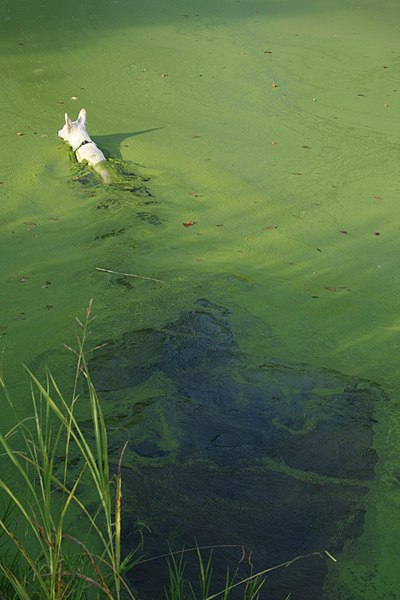
Image credit: Wikimedia
One case study focuses on clam toxins. I teach about this by first displaying headlines of dogs becoming ill then dying after swimming in green water, along with images depicting dead marine life near red- or green-colored waters. I ask students: What is causing this? Several of my students cite toxic algae, having previously heard the news reports. This leads to the follow-up question to launch our investigation: Why are some algal blooms toxic?
To answer this driving question, my students first engage in knowledge-building activities. I have them do the following:
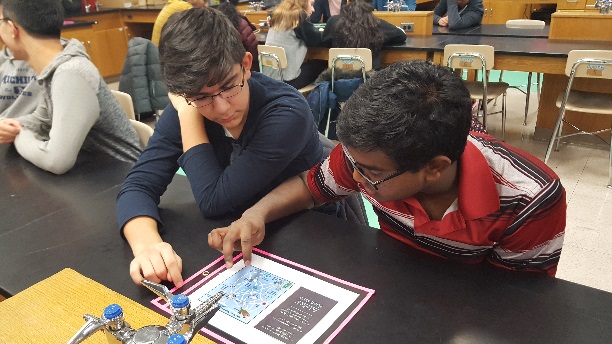
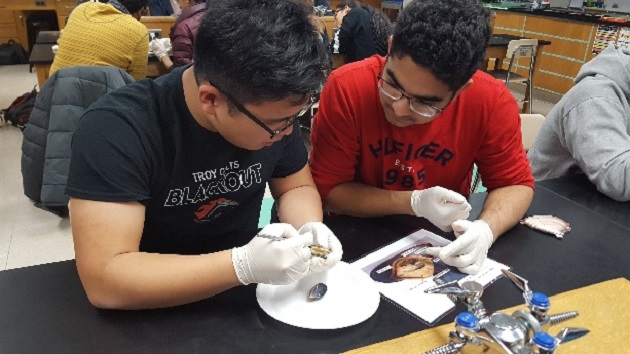
- Examine maps to understand geographically where the blooms occur.
- Analyze a marine food web to see how the toxin moves through an aquatic ecosystem.
- Dissect a bivalve to learn about its anatomy: most notably, the two body systems we will investigate, nervous and muscular.
These initial activities segue into modeling how a neuron fires an action potential. Depending on the student’s grade level, the teacher may choose to provide an overview of the events: 1) dendrites stimulated, 2) axon opens channels, 3) molecules are released in the synapse, and 4) a muscle cell contracts. This simplified sequence could be used for the NGSS performance expectation HS-LS1-2, linking two interacting body systems, which is a component of the disciplinary core idea HS-LS1.A.
For an AP course, in which I implement this case study, a detailed account of ion movement, the neurotransmitters involved, and cell-to-cell communication covers essential knowledge 3.E.2 in the AP Biology Curriculum Framework.
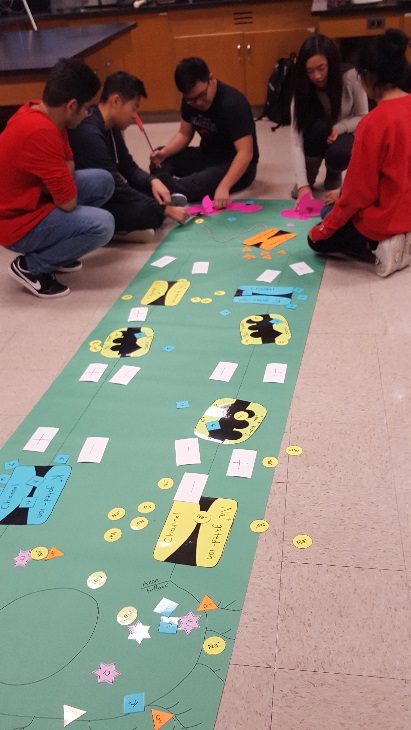
Using bulletin-board paper and laminated cutouts, my students demonstrate how a neuron “talks” to a muscle cell.
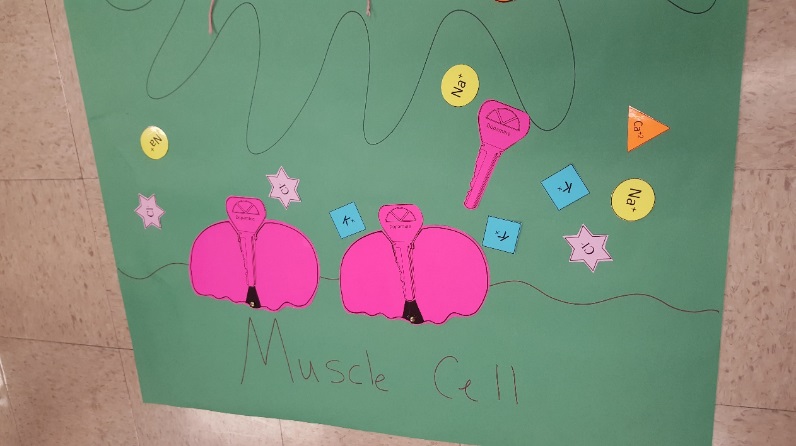
The connection between structure and function unfolds as the students see specific ions (Na+ and K+) fitting together like puzzle pieces into Na-K pumps located along the axon and “keys” (neurotransmitters) fitting into specific “locks” (receptors) on the adjacent muscle cell.
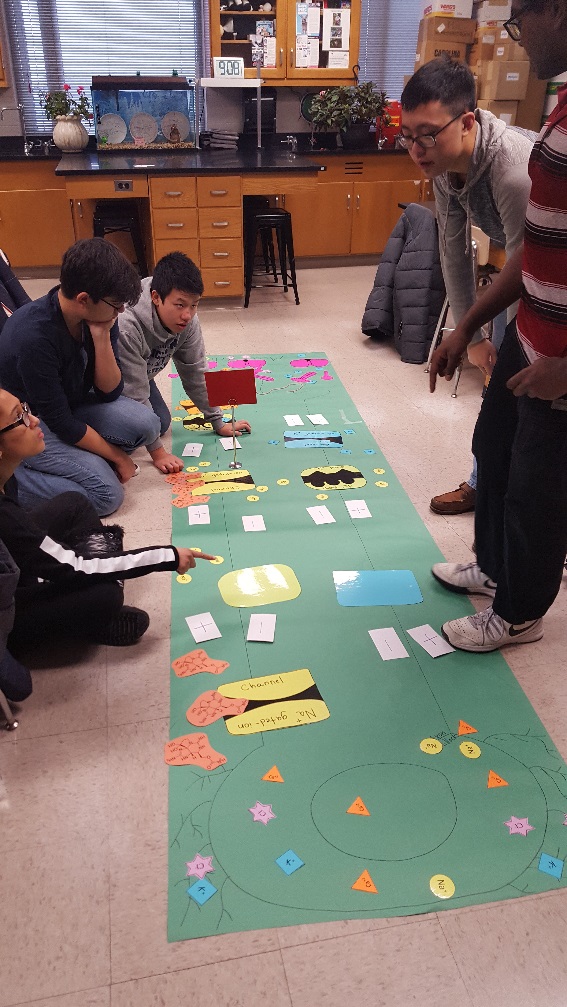
The neurotoxin (saxitoxin) is peach-colored above.
To connect these actions to the clam case study, the neurotoxin released by the algae (saxitoxin) is introduced. I ask students these questions:
How does the toxin’s structure enable it to interact with the neuron?
How does the toxin affect the function of the nerve impulse?
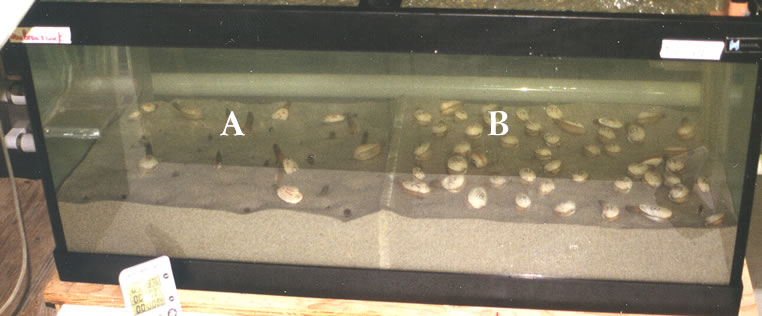
Image credit: MacQuarrie & Bricelj MEPS 2008
The lesson continues with the students observing a photo of two populations of clams in the presence of the neurotoxin and asking this: What impact will the toxin have on the muscle? Tank B contains clams that are sensitive to the toxin, rendering them unable to burrow and escape predators. Tank A contains clams with a genetic mutation that alters the shape of the channel, preventing the toxin from binding. Toxin-resistant clams can still burrow and extend their siphons to feed. By demonstrating structure and function on a genetic level, students realize that when the toxin is present, mutated clams are more evolutionarily fit.
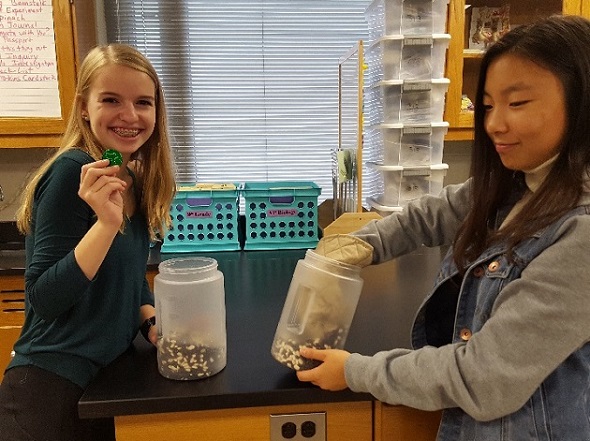 The case study culminates by having students examine a negative consequence of a mutated channel when the toxin is absent from the environment. Researchers observed that the mutation affects the efficiency rate of a nerve impulse. To model this impairment, one student wears an oven mitt to hinder movement while digging in a container of substrate to retrieve a hidden object, while another student designated as lacking the mutation models a more agile burrower by searching for the object with a bare hand. This demonstrates once again how structure affects clam behavior and why nature maintains variation.
The case study culminates by having students examine a negative consequence of a mutated channel when the toxin is absent from the environment. Researchers observed that the mutation affects the efficiency rate of a nerve impulse. To model this impairment, one student wears an oven mitt to hinder movement while digging in a container of substrate to retrieve a hidden object, while another student designated as lacking the mutation models a more agile burrower by searching for the object with a bare hand. This demonstrates once again how structure affects clam behavior and why nature maintains variation.
From start to finish, this case study engages students in the interplay between structure and function. Each component builds upon authentic, coherent discoveries to cultivate analytically-minded students. As you design lessons around this crosscutting concept, consider these questions:
What “why questions” will you ask your students?
How will structure and function allow your students to deepen their learning experiences?

Rebecca Brewer teaches Advanced Placement and ninth-grade biology at Troy High School in Troy, Michigan. With more than 19 years of experience, Brewer hopes her constructivist approach to instruction—which emphasizes student-led learning—sparks students’ passion for biological concepts. She has co-authored the high school biology textbook Biology Now; works for MiniOne, a biotechnology company that is training teachers to use its kits and equipment; and creates educational digital resources for Science Friday and PBS NewsHour Extra. In addition, she serves as the director of Michigan’s Outstanding Biology Teacher Award program, and is a past honoree.
In 2011, Brewer received $27,000 for her classroom as the first-place winner of the ING Unsung Hero Award, and in 2007, she was a named a member of USA Today’s All-USA Teacher Team, which recognizes the top 20 educators in the United States. You can contact her on Twitter: @brewerbiology.
Note: This article is featured in the October 2018 issue of Next Gen Navigator, a monthly e-newsletter from NSTA delivering information, insights, resources, and professional learning opportunities for science educators by science educators on the Next Generation Science Standards and three-dimensional instruction. Click here to sign up to receive the Navigator every month.
The mission of NSTA is to promote excellence and innovation in science teaching and learning for all.
Disclaimer: The views expressed in this blog post are those of the author(s) and do not necessarily reflect the official position of the National Science Teaching Association (NSTA).
Biology Crosscutting Concepts Disciplinary Core Ideas Life Science NGSS Phenomena Science and Engineering Practices Teaching Strategies Three-Dimensional Learning High School


